Side Effects
May include... Examining Medications With the Most Frequent and Severe Side Effects
To say medicine has had a profound effect on many people’s quality of life would be an understatement. One study shows that more than half of all Americans take at least one prescription drug. But what happens when the medicines we rely on cause side effects as severe as the diseases or conditions they’re supposed to treat?

We analyzed the SIDER Side Effect Resource, a compilation of globally recognized medications and their side effects, to determine which prescription and over-the-counter drugs had the highest number of and most severe side effects.
Many of these side effects are found during clinical trials, which are required by the U.S. Food and Drug Administration as a part of the drug approval process. Although drugs go through several rounds of trials, extreme adverse effects can still occur once medications have been released into the market for public use, resulting in injury, illness, and in some cases, death.
Taking prescription drugs should be a positive experience that improves people’s overall sense of health, so read on to learn how common medications compare to one another when it comes to their side effects.
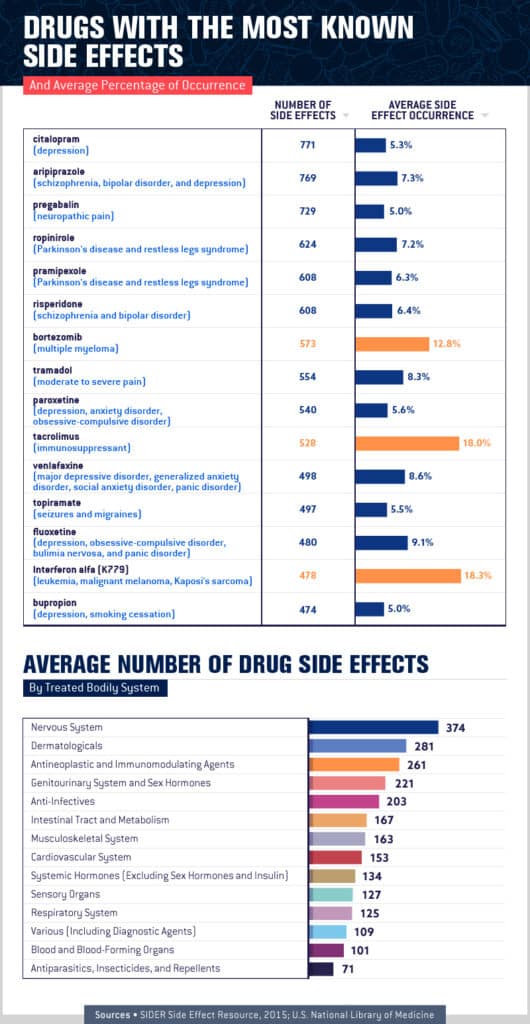
Which Drugs Have the Most Documented Side Effects?
Medications that treat the nervous system, including common antidepressants, have the highest number of side effects. Citalopram, a selective serotonin reuptake inhibitor (SSRI) prescribed to treat depression, had 771 side effects, followed by aripiprazole, an antipsychotic used to treat schizophrenia and other psychiatric conditions.
Other drugs used to treat nervous system disorders appeared on our list as well, with numerous opioids also making an appearance. Often, opioids are discussed in the context of addiction and abuse, but even under physician supervision, patients using these drugs can experience a wide range of side effects including withdrawal syndrome, dry mouth, constipation, and confusion. Tramadol, a narcotic pain medication, had 554 reported side effects, and as we’ll discuss later, fentanyl had 470.
Drugs involving blood and blood-forming organs, as well as antiparasitic medications, had the fewest side effects on average.

Which Drugs Have the Most Frequently Occurring Side Effects?
While the antiparasitic drugs had the fewest side effects, pentamidine – a drug used to treat pneumonia – had the most frequently occurring side effects on average.
Although pentamidine’s side effects of coughing and fatigue may not seem especially severe, the frequency with which they occur is above average.
Other drugs mentioned in this chart have side effects that are both frequent and severe. For example, the label for the HIV treatment stavudine warns potential users that the drug could cause fatal lactic acid buildup and hepatomegaly (liver enlargement).
Asthma is a relatively common disease that affects over 20 million American adults, but aminophylline, a drug used to treat it, has some side effects that can negatively affect the heart. Sinus tachycardia, for example, means having an increased heart rate of over 100 beats per minute. This affected more than 82 percent of those who used the drug. Another common side effect is low potassium levels, or hypokalemia, which occurred in about 63 percent of patients. In some cases, low potassium can cause heart palpitations and abnormal heartbeats.
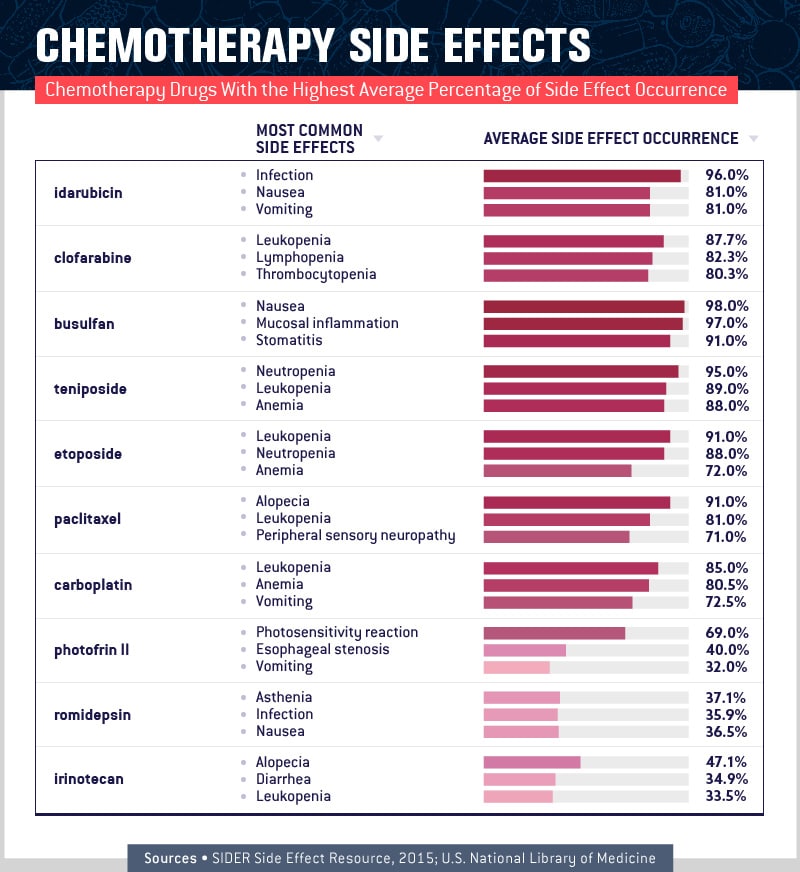
Cancer Drugs and Their Side Effects
The history of chemotherapy began during World War II when the bone marrow cells of soldiers exposed to mustard gas were found to be mutated. Researchers began to build on this initial discovery to create a potential treatment for lymphoma, and since then, many other forms of cancer have been successfully treated with chemotherapy.
Since chemotherapy drugs work by killing rapidly growing cells in the body, it’s no surprise that their side effects can be among the most severe. The most common side effects, such as nausea or vomiting, can make cancer treatment difficult to cope with. Eating smaller meals, increasing fluid intake, and avoiding spicy or fried foods can make these gastrointestinal side effects less severe.
However, changes in chemotherapy drug distribution, as well as their intended treatment demographics, can change based on new research. As an example, clofarabine has recently been approved as an injectable to help treat children with certain types of leukemia.
But not all chemotherapy drugs will perform the same when applied in different forms or dosages, or when used in treatments outside of the scope of their original use. For example, oral etoposide was shown to underperform in specific cases in one clinical study, thus leading to its discontinuation as a possible treatment course.
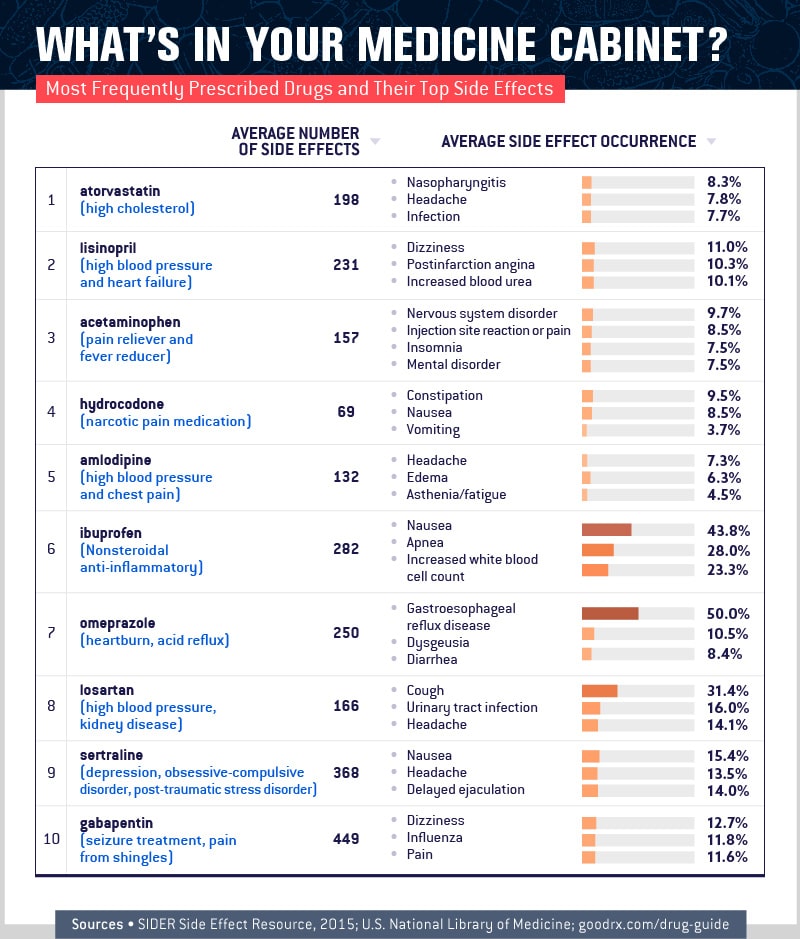
Commonly Prescribed Medications and Their Side Effects
Even the most commonly used prescription drugs have potentially unpleasant side effects. We looked at the most commonly filled prescriptions in August 2018 and examined their most frequently occurring side effects. Atorvastatin, a drug used to treat high cholesterol, was the No. 1 most commonly filled prescription in the U.S., and it has 198 known side effects.
Even acetaminophen, a popular pain relief medicine that’s available without a prescription, had some surprising side effects: Insomnia and mental disorders occurred in 7.5 percent of cases.
According to the National Center for Health Statistics, about 13 percent of Americans use antidepressants. Sertraline, the ninth-most filled prescription in August 2018, is one of the most popular medications used to treat depression. It has 368 reported side effects in all, but the most common ones affect several parts of the body, from the gastrointestinal system to sexual organs.
In some cases, prescription or over-the-counter medications may cause symptoms just as severe as the conditions they treat. For example, omeprazole, which is used to treat heartburn and acid reflux, caused gastroesophageal reflux disease (also known as GERD) in half of the patients who took it and reported their symptoms.

Adverse Opioid Reactions
Opioids have been at the center of many drug-related lawsuits, and it’s difficult to go long without hearing about the devastation caused by the opioid crisis in the U.S. Opioids are particularly susceptible to being abused because they disrupt the pain centers of the brain while elevating dopamine (the “feel-good hormone”).
Despite this potential for abuse, some opioid drugmakers might likely be aware of the issue yet continue to market their products as safer, less-addictive alternatives to other medications.
Adding to the common (and sometimes severe) opioid side effects like nausea and constipation are the withdrawal effects. Over 1 in 5 patients under medical supervision experienced withdrawal symptoms when taking opioids.


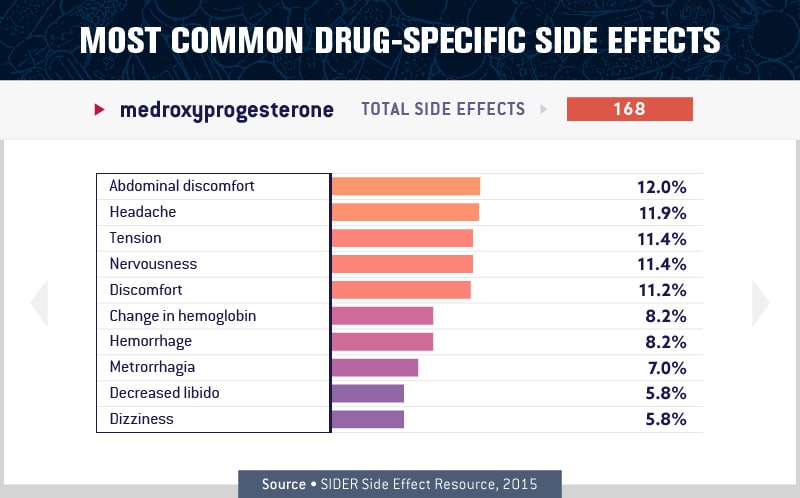

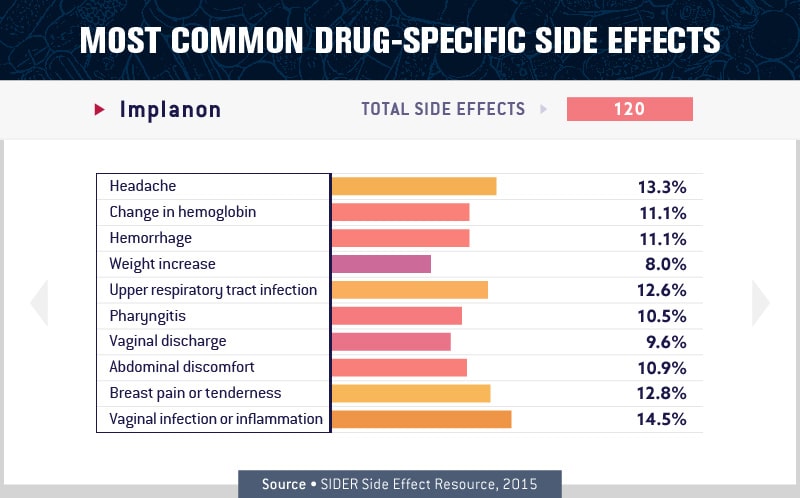
Adverse Birth Control Reactions
It can be shocking to hear the long list of side effects at the end of a prescription drug advertisement on the radio or TV, but sharing that kind of important health information hasn’t always been required for all medications. The public demand for side effects to be listed alongside medications grew when hormonal birth control became available. People wanted to know more about what they were putting into their bodies, and new reforms and regulations were passed to make this information mandatory for all birth control drugs.
Some people may only worry about the resulting side effects like acne or weight gain when it comes to birth control. However, these are not the only side effects people experience while on the pill or any other type of hormonal contraception.
According to the SIDER data, about 12 percent of people using one of four forms of hormonal birth control experienced nervous system disorders or ovarian cysts. Additionally, a recent Danish study found a connection between hormonal contraception and depression, but this connection is still up for debate in the medical community.
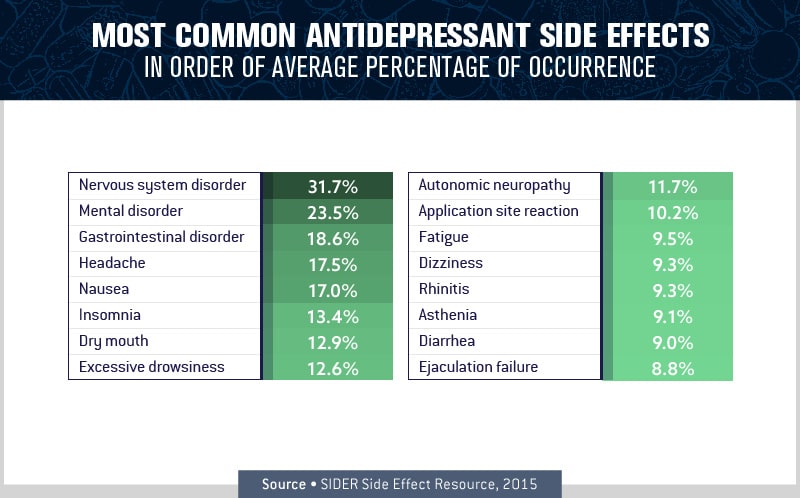


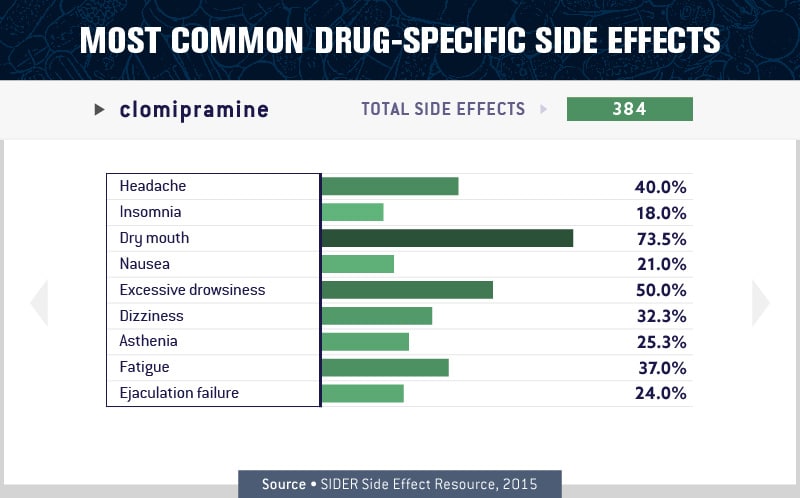

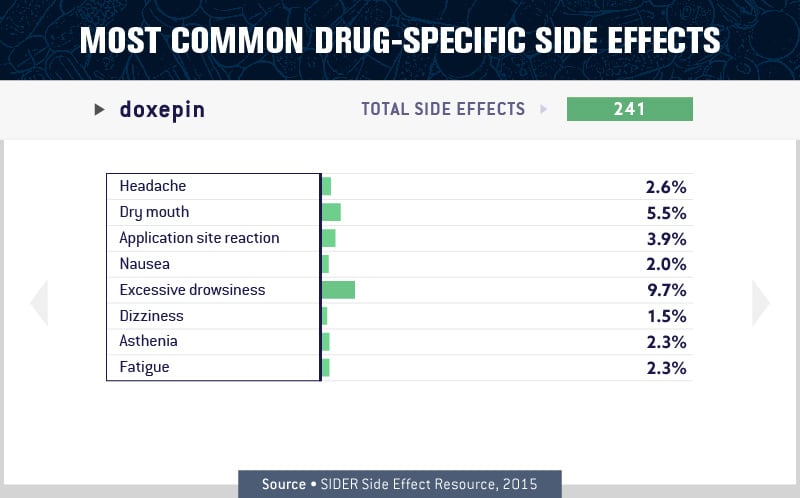
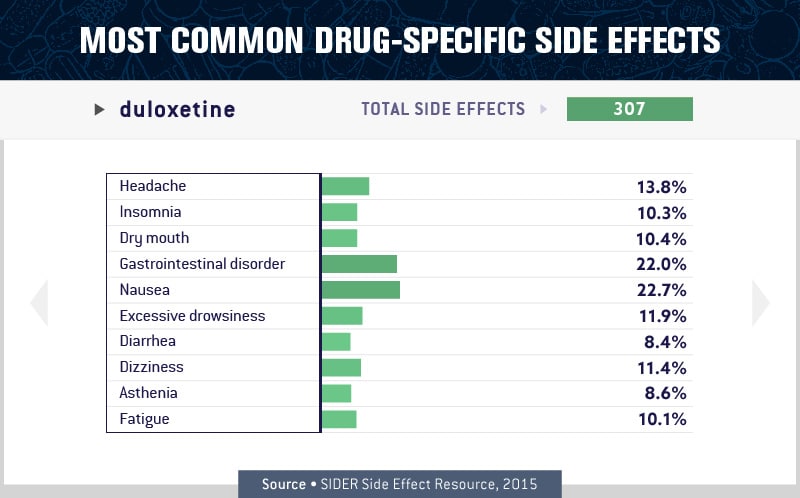
Adverse Antidepressant Reactions
Antidepressants have also been involved in high-profile lawsuits. Considering that the top side effect of some antidepressants is nervous system disorders (which include disorders of the brain, spinal cord, cranial and peripheral nerves, nerve roots, nervous system, and neuromuscular system), these medications may have serious consequences for patients.
Other common reactions to antidepressants may include dry mouth, sexual issues, nausea, and headaches. In fact, citalopram had the most side effects of any drug profiled with 771.
And the long-term use of these drugs is surging, having more than tripled since 2000.
Anxiety medications, including anxiolytics and benzodiazepines, may also come with side effects that range from salivation to more severe issues like cognitive and memory disorders.
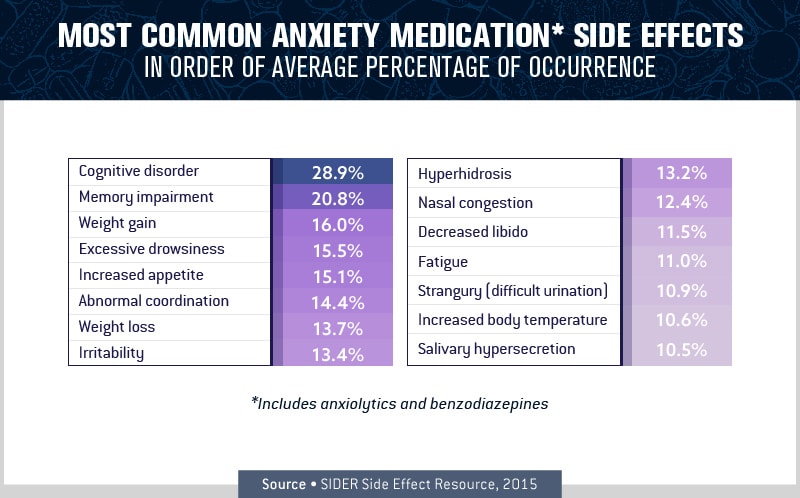
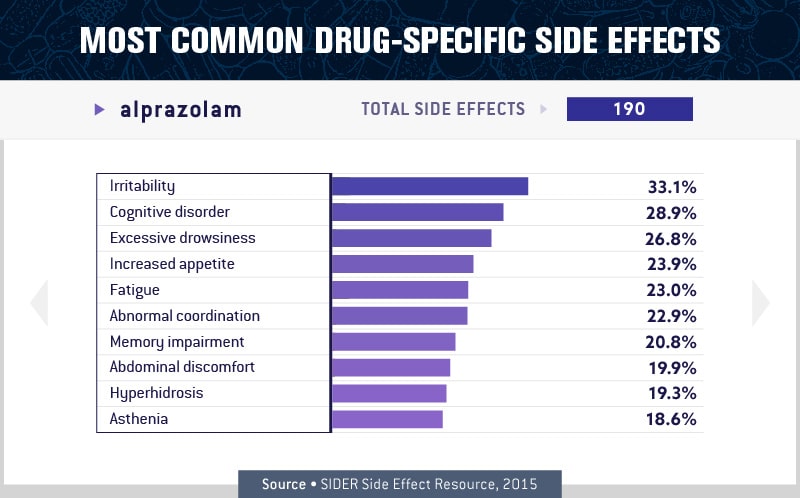
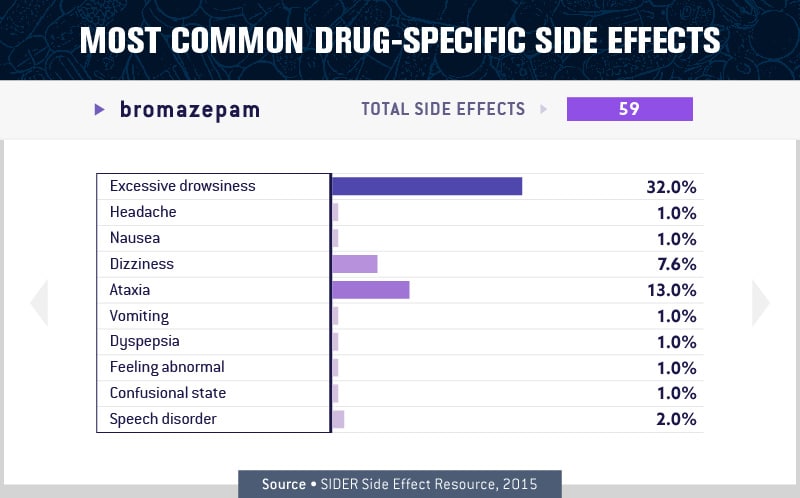

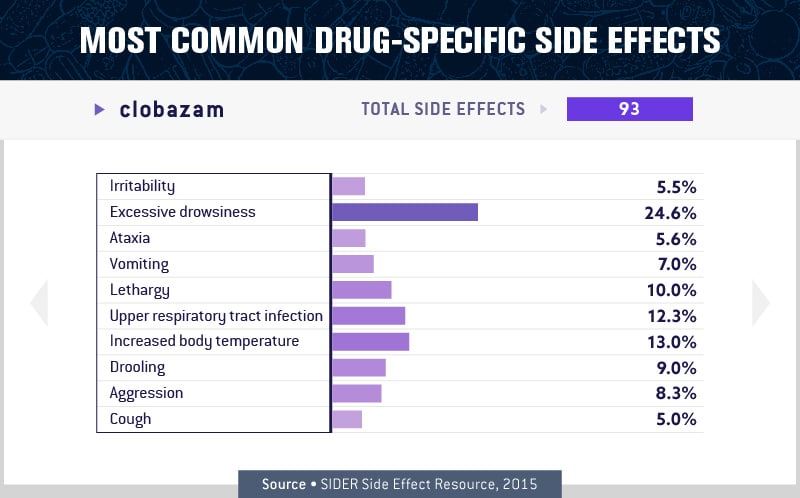


Adverse Anxiety Medication Reactions
Today, about 40 million American adults have an anxiety disorder – and about 31 percent will experience one at some point in their life. Given the far-reaching impact of anxiety disorders, drugs used to treat anxiety have grown in popularity: Between 1996 and 2013, the number of benzodiazepine prescriptions filled grew by 67 percent.
Anxiety medications might not get as much media attention as opioids, but they could be fueling the next big drug crisis. Benzodiazepine overdoses have quadrupled since 1996, a rate that has increased faster than the prescription rate.
Over the short term, people taking anxiolytic drugs may experience irritability, cognitive disorders, or excessive drowsiness. But 20 to 30 percent of people using benzodiazepines for more than a few weeks, even under medical supervision, will develop an addiction.


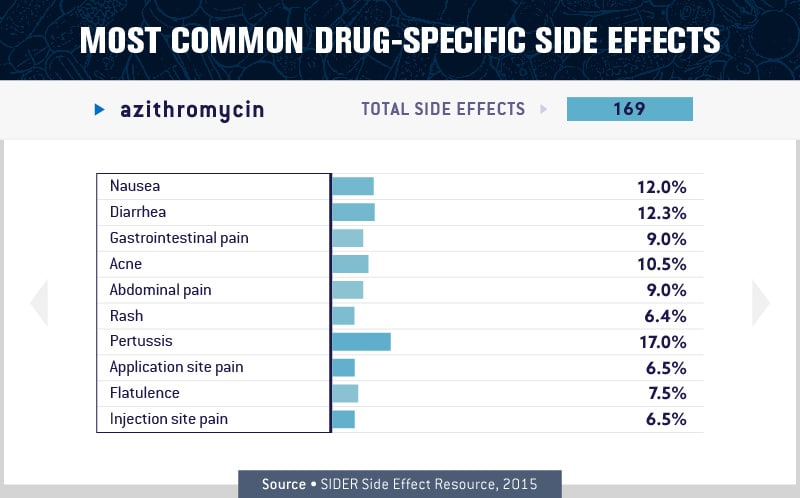

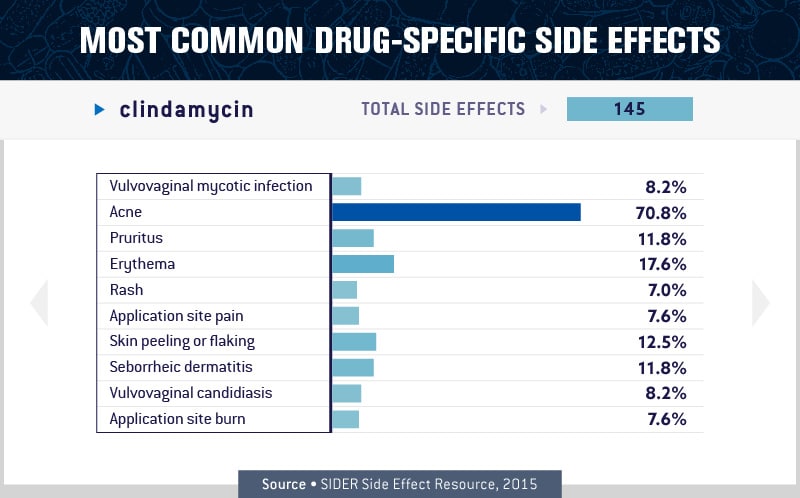
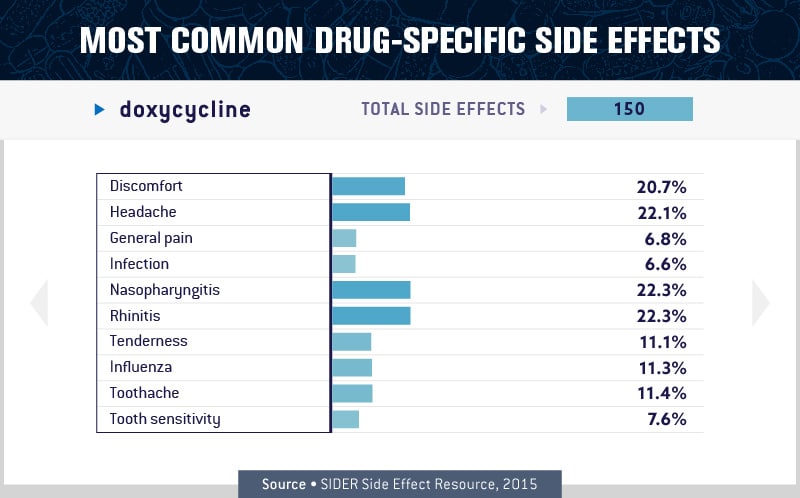
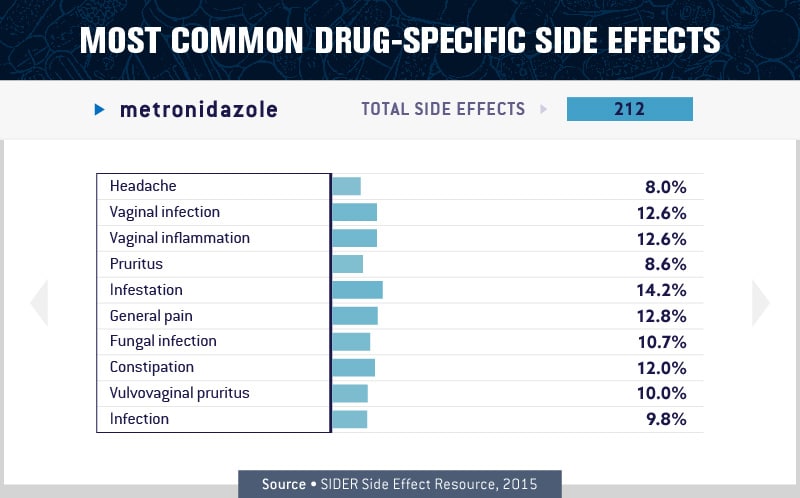
Adverse Antibiotic Reactions
The most common side effect of taking certain antibiotics was acne at over 53 percent. However, the next most common side effect is a type of pneumonia.
Klebsiella bacteria normally exist within the gut and don’t usually cause trouble. However, an overgrowth of klebsiella can cause symptoms like coughing and difficulty breathing.
From our analysis, ciprofloxacin had the most side effects. It is an antibiotic often used to treat traveler’s diarrhea, which can lead to severe dehydration. While antibiotics can provide much-needed relief from illnesses caused by bacteria like urinary tract infections, strep throat, and certain pneumonias, they can also interfere with healthy bacteria in the body. Taking probiotics, eating fermented foods, and eating a high-fiber diet can help maintain a healthy balance of bacteria in your digestive system while on antibiotics.
Don't Stop Your Medications – But Stay Informed
We don’t share these side effects to frighten you but rather to inform you of what can happen with various prescription and over-the-counter medications. Prescriptions have saved innumerable lives, but new research and studies show even life-saving drugs can come with serious drawbacks.
If you are taking a new prescription or over-the-counter medication, take note of any side effects you experience and immediately speak with your doctor. There’s nothing wrong with being cautious around medications – only you and your doctor know you best.
Methodology
Using the SIDER Side Effect Resource, we analyzed the frequency of 5,868 side effects in 1,430 internationally recognized drugs. The latest version of these data was released in October 2015. The producers of this data set aimed to aggregate dispersed public information on side effects, which is not otherwise available in such a comprehensive, accessible format.
The frequency of drug side effects represented in the data set is comprised of side effect information from a selection of drug labels. Therefore, the side effect frequency data presented in our findings represent an average from a number of labels.
Our visualizations do not include the frequency of side effects for placebos, and they only include the average frequency for the “preferred terms” of side effects, rather than the lowest-level term. In some places, terms with synonymous meanings (e.g., asthenia and fatigue) were combined to avoid redundancy in our visualizations.
To determine the average number of side effects for drugs used to treat specific bodily systems, we grouped drugs based on an indication according to their Anatomical Therapeutic Chemical (ATC) codes. The ATC classification is an internationally accepted classification system for medicines.
To determine the drugs with the greatest frequency of side effects, only drugs with greater than five side effects were included.
To determine the most commonly occurring opioid side effects, we averaged the frequencies of side effect occurrence for the following drugs:
- Buprenorphine
- Butorphanol
- Hydromorphone
- Morphine
- Oxycodone
- Tapentadol
- Tramadol
To determine the most commonly occurring antidepressant side effects, we averaged the frequencies of side effect occurrence for the following drugs:
- Amoxapine
- Citalopram
- Bupropion
- Clomipramine
- Desvenlafaxine
- Doxepin
- Duloxetine
- Fluoxetine
- Fluvoxamine
- Reboxetine
- Sertraline
- Venlafaxine
To determine the most commonly occurring anxiety medication side effects, we averaged the frequencies of side effect occurrence for the following drugs:
- Alprazolam
- Bromazepam
- Buspirone
- Clobazam
- Diazepam
- Estazolam
- Flunitrazepam
- Lorazepam
- Midazolam
- Quazepam
- Temazepam
- Triazolam
- Zaleplon
- Zolpidem
To determine the most commonly occurring antibiotic side effects, we averaged the frequencies of side effect occurrence for the following drugs:
- Amoxicillin
- Azithromycin
- Cephalexin
- Ciprofloxacin
- Clavulanate
- Clindamycin
- Doxycycline
- Levofloxacin
- Metronidazole
- Sulfamethoxazole
- Trimethoprim
To determine the most commonly occurring hormonal birth control side effects, we averaged the frequencies of side effect occurrence for the following drugs:
- Implanon
- Levonorgestrel
- Medroxyprogesterone
- Megestrol
Limitations
Only 39.9 percent of the 139,756 drug side effect combinations available to us had frequency information. Any side effects without frequency information were not included in our analysis. If all of the drug-side effect pairs had frequency information, our findings could have varied greatly. Further data collection and analysis should be done to fully explore the relationship between drugs and their adverse reactions.
Sources
- https://www.consumerreports.org/prescription-drugs/too-many-meds-americas-love-affair-with-prescription-medication/
- http://sideeffects.embl.de/
- https://www.fda.gov/patients/drug-development-process/step-3-clinical-research
- https://www.vox.com/2018/9/26/17901778/opioid-epidemic-solutions-policy-explainers
- https://medlineplus.gov/druginfo/meds/a601208.html
- https://aidsinfo.nih.gov/drugs/43/stavudine/25/professional#nlm42232-9
- https://www.cdc.gov/nchs/fastats/asthma.htm
- https://www.healthline.com/health/sinus-tachycardia#inappropriate-sinus-tachycardia
- https://medlineplus.gov/ency/article/000479.htm
- https://www.cancer.org/cancer/understanding-cancer/history-of-cancer/cancer-treatment-chemo.html
- https://www.mayoclinic.org/tests-procedures/chemotherapy/about/pac-20385033
- https://my.clevelandclinic.org/health/articles/10257-chemotherapy-side-effects
- https://www.mdedge.com/hematology-oncology/article/151736/all/generic-clofarabine-injection-hits-market
- https://www.niaid.nih.gov/node/7937?404message&requested_url=/news-events/aids-kaposi%E2%80%99s-sarcoma-study-changed-due-drug-underperformance
- https://www.goodrx.com/drug-guide
- https://time.com/4900248/antidepressants-depression-more-common/
- https://www.biospace.com/article/-jc1n-in-negotiations-of-1-000-opioid-lawsuits-purdue-pharma-offers-free-opioid-therapy/
- https://www.cnn.com/2017/09/18/health/opioid-crisis-fast-facts/index.html
- https://www.nytimes.com/2018/05/29/health/purdue-opioids-oxycontin.html
- https://www.businessinsider.com/how-drug-ads-describe-side-effects-2016-2
- https://www.pbs.org/wgbh/americanexperience/features/pill-senate-holds-hearings-pill-1970/
- https://www.health.harvard.edu/blog/can-hormonal-birth-control-trigger-depression-201610172517
- http://time.com/5172964/does-birth-control-cause-depression/
- https://www.nytimes.com/2017/09/11/well/mind/paxil-antidepressants-suicide.html
- http://sideeffects.embl.de/se/C0027765/
- https://www.nytimes.com/2018/04/07/health/antidepressants-withdrawal-prozac-cymbalta.html
- https://www.nimh.nih.gov/health/statistics/any-anxiety-disorder
- https://nida.nih.gov/research-topics/opioids/benzodiazepines-opioids
- https://www.baltimoresun.com/health/bs-hs-xanax-valium-next-drug-crisis-20180313-story.html
- https://www.nbcnews.com/health/health-news/anxiety-drug-overdoses-have-quadrupled-over-last-two-decades-study-n521086?icid=related
- https://thehill.com/opinion/healthcare/408350-theres-a-new-drug-crisis-harming-americans/
- https://www.webmd.com/a-to-z-guides/klebsiella-pneumoniae-infection
- https://wwwnc.cdc.gov/travel/yellowbook/2024/preparing/travelers-diarrhea
- https://healthy.kaiserpermanente.org/washington/health-wellness?item=%2Fcommon%2FhealthAndWellness%2Fmedications%2FmanagingMedications%2Fantibiotics.html
- https://www.healthline.com/nutrition/what-to-eat-antibiotics#section3
Fair Use Statement
When it comes to your health, knowledge is power – so please feel free to share the information above with anyone who’d find it useful (only for noncommercial purposes). You’ll just need to link back to this article so that all involved are recognized for their effort.


